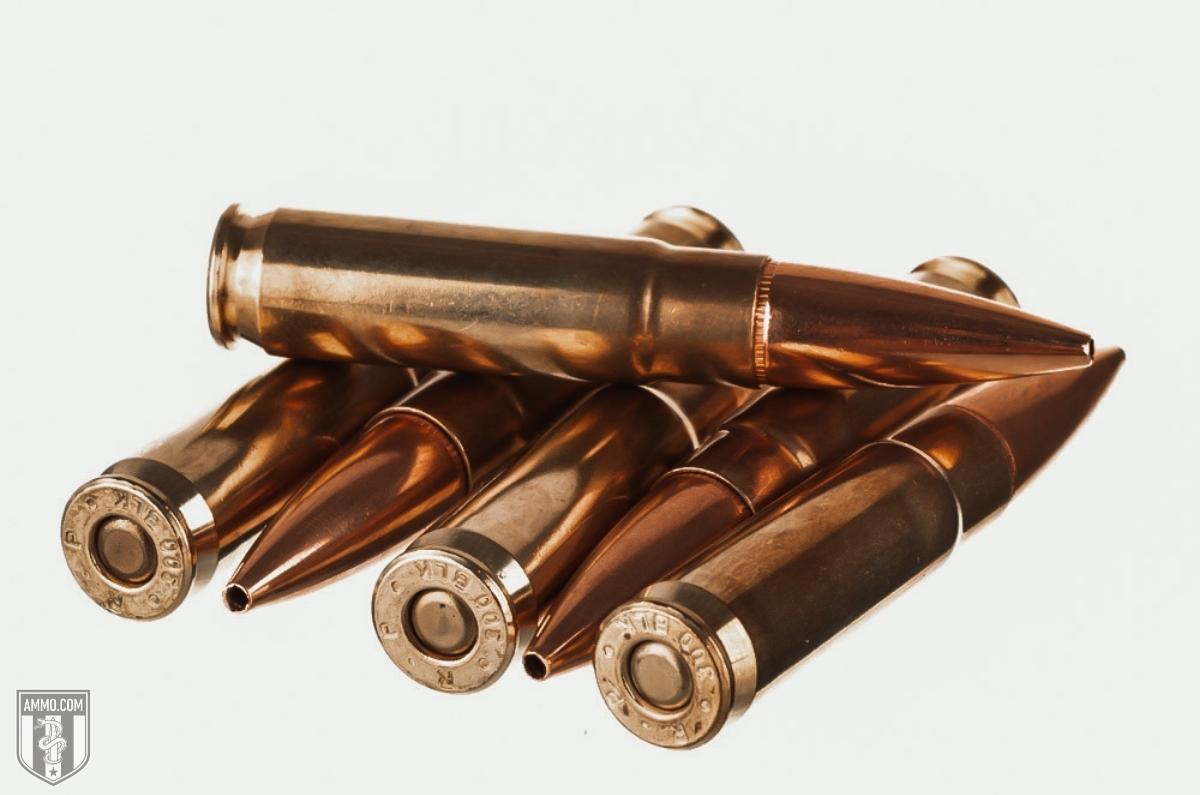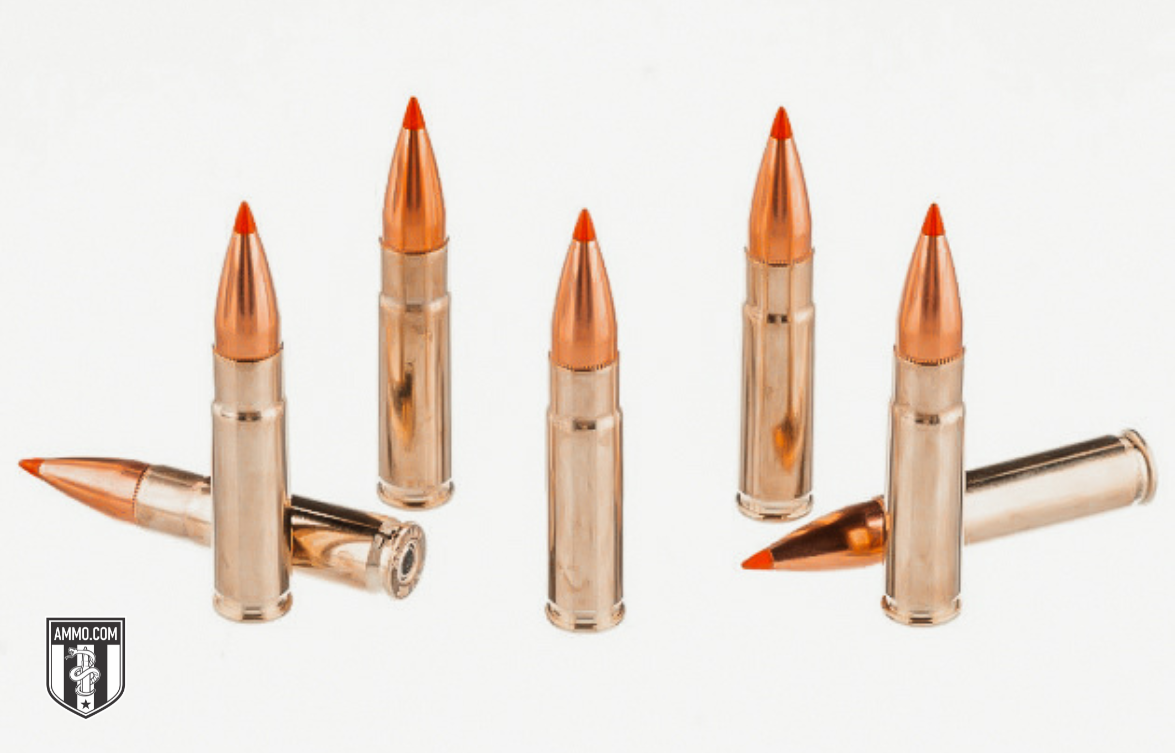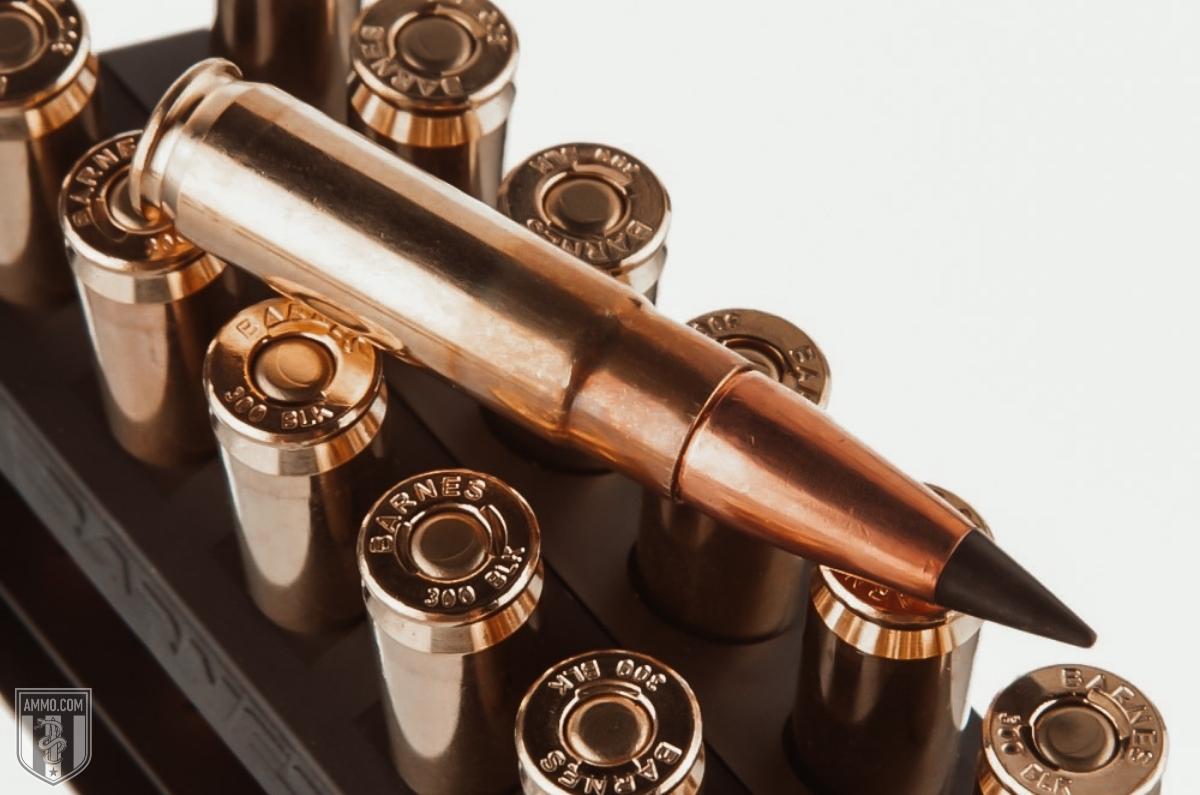350 Legend vs. 300 Blackout: Purpose-Driven Rifle Cartridges
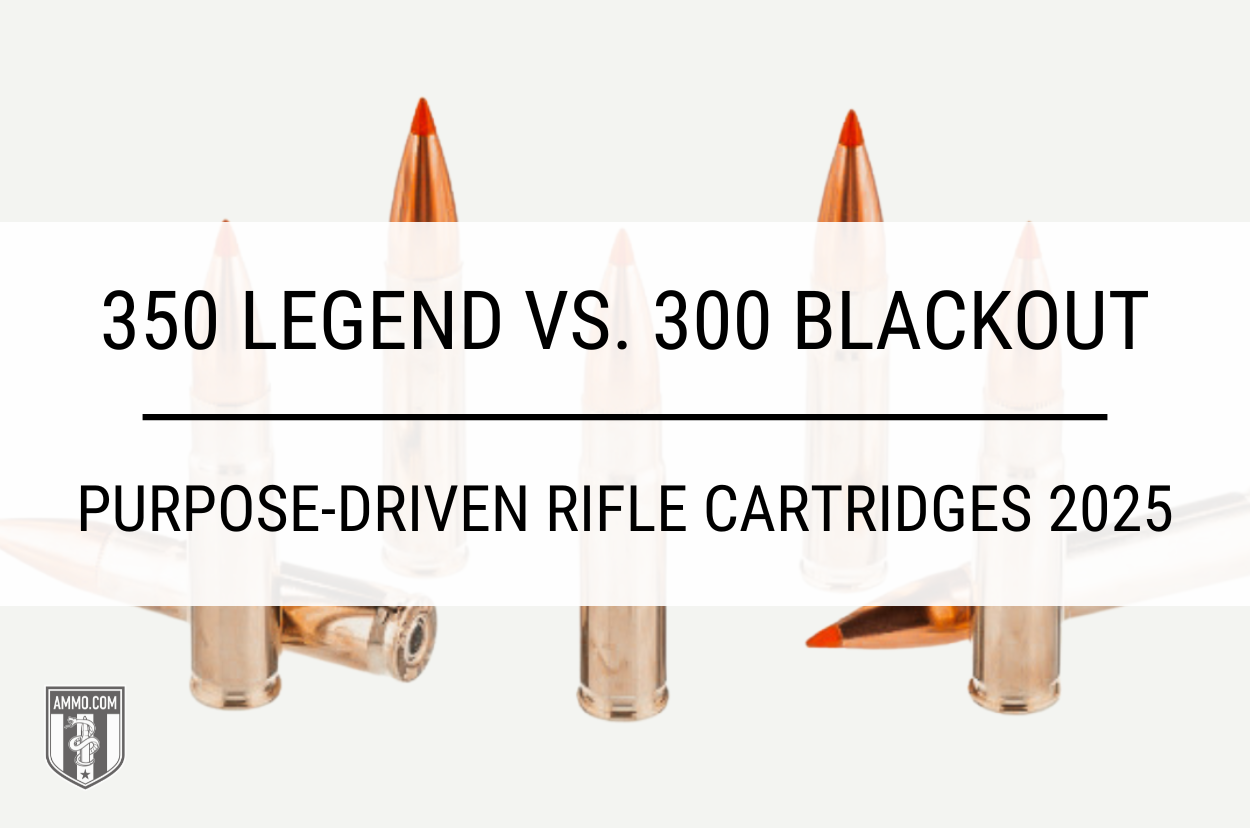 The 350 Legend and 300 AAC Blackout are two centerfire rifle cartridges that are often used to bag trophy bucks and stock freezers full of venison.
The 350 Legend and 300 AAC Blackout are two centerfire rifle cartridges that are often used to bag trophy bucks and stock freezers full of venison.
While both rounds are excellent options for taking down whitetail and feral hogs, their intended purposes differ greatly. The 350 Legend was developed by Winchester specifically as a hunting round, whereas the 300 Blackout was developed for U.S. special forces’ suppressed AR-15s.
While it may have been intended for urban combat, the 300 Blackout has been accepted by the hunting community as an effective dispatcher of whitetail deer, and is used to good effect by many each fall.
Let’s take a deep dive into the 350 Legend vs. 300 Blackout ammo debate, analyzing the advantages and disadvantages of each so you can make a more informed decision on your next hunting rifle.
What is the Difference Between 350 Legend and 300 Blackout?
The primary differences between the 350 Legend and 300 Blackout are each cartridge’s bullet diameter and case design. The 350 Legend fires a 0.355” diameter bullet from a straight-walled case, while the 300 Blackout fires a 0.308” diameter bullet from a bottleneck one.
350 Legend vs. 300 Blackout Cartridge Specs
The 300 Blackout cartridge has a bottleneck case; the 350 Legend, a straight-walled one.
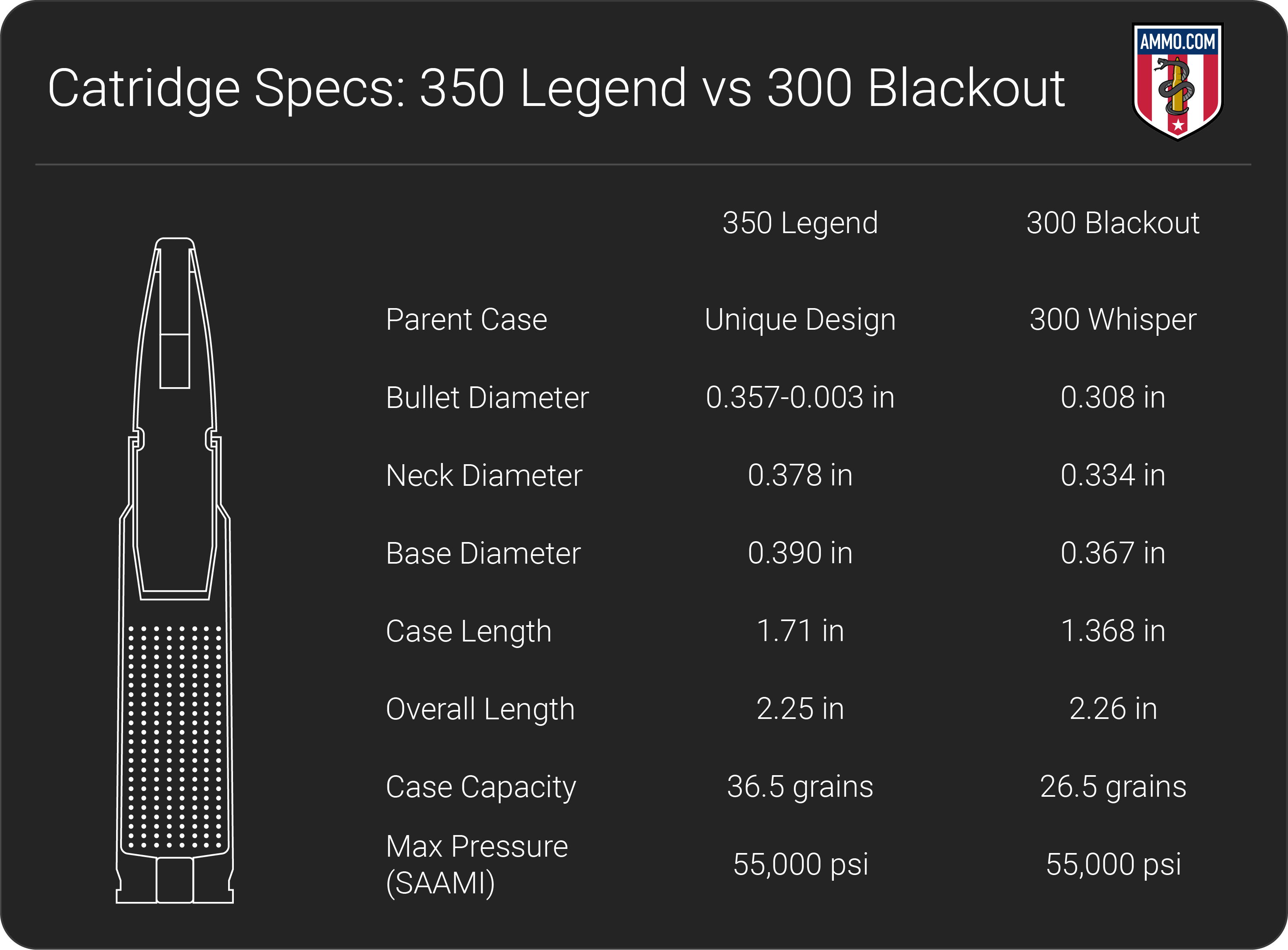
The next significant difference is each cartridge’s bullet diameter. The 300 Blackout fires the popular .30 caliber bullet – 0.308” diameter, specifically. For the 350 Legend, Winchester uses a bit of marketing magic to describe their cartridge’s projectile.
Bullet diameter for 350 Legend is listed as 0.357”-0.003”. That’s odd, since caliber is usually a single diameter measurement. This is due to specific U.S. state requirements that rifle cartridges used for deer hunting must fire a bullet with a minimum diameter of 0.357”.
On its website, Winchester lists the 350 Legend as firing a 0.357” caliber bullet. However, all reloading data recommend using 0.355” (aka 9mm) bullets. Although the 350 Legend is capable of firing a 0.357” diameter bullet, it is more frequently loaded with the slightly narrower 0.355” bullet.
One similarity between the 350 Legend and 300 AAC Blackout is their identical rim diameter to the 223 Remington: 0.378”. That’s why adapting a 5.56/223 AR-15 to 350 Legend requires nothing more than a barrel change.
While the 350 Legend and 300 Blackout’s lengths are nearly identical, their case capacities are quite a different story. The 350 Legend’s longer and wider case is around 38% more capacious than the 300 Blackout’s; 36.5 grains H2O vs. 26.5.
Its higher-capacity case allows the 350 Legend to fire a heavier bullet – but how does that affect recoil?
350 Legend vs. 300 Blackout Recoil
One of Winchester’s main selling points for the 350 Legend is its low recoil: 63% less than the 450 Bushmaster, which is another popular straight-walled deer hunting cartridge. That’s impressive, but how does the 350 Legend’s kick stack up against the 300 Blackout’s?
The average supersonic 300 Blackout ammo has 6 ft-lbs of free recoil; the 350 Legend, 8.5 ft-lbs.
Although the 350 Legend does technically generate more recoil than the 300 BLK, neither is oppressive to fire. Marksmen commonly describe either as having low recoil.
Muzzle Velocity and Kinetic Energy
Muzzle velocity, measured in feet per second (fps), is the speed at which the bullet exits the barrel of the firearm. Generally, a longer barrel will generate a higher muzzle velocity, as it gives exploding propellant more time to transfer its energy to the bullet.
Muzzle energy is measured in foot-pounds (ft-lbs), and describes how much force a bullet delivers to its target at a given range.
Both cartridges’ 150 grain Winchester Deer Season XP loadings will be considered for this comparison. According to Winchester’s own data, the 350 Legend has 2,325 fps muzzle velocity and 1,800 ft-lbs muzzle energy (from a 20” barrel). By comparison, the 300 Blackout has 1,900 fps muzzle velocity and 1,200 ft-lbs muzzle energy from a 16” barrel).
The 350 Legend is clearly superior in terms of muzzle velocity and energy.
Trajectory
Trajectory is how we quantify a bullet’s flight path as it travels downrange, measured in inches of drop. A flatter-shooting cartridge is preferred for firing across longer ranges, as it requires the shooter to make fewer adjustments to compensate for bullet drop. Its flatter trajectory also means a cartridge will be more forgiving of ranging mistakes.
As the 350 Legend has a higher muzzle velocity, it generally also has a flatter trajectory.
Comparing the same 150gr Winchester Deer Season XP loadings as before, we see that the 350 Legend exhibits -7.6” drop at 200 yards. That makes its trajectory much flatter than the 300 Blackout’s, which drops -9.0” at the same range.
The 350 Legend’s flatter trajectory may not prove to be a huge advantage at short range. It is undeniably advantageous over longer distances, though.
The differences in their trajectories account for the difference between the two rounds’ effective ranges. Winchester promises that the 350 Legend is effective on whitetail out to 250 yards, whereas the 300 Blackout’s maximum hunting effective range is around 175 yards on a good day.
300 Blackout vs. 350 Legend Ballistic Coefficient
Ballistic coefficient (BC) is a measure of how efficiently a bullet resists wind drift and air resistance. Put another way, it’s a numeric representation of how aerodynamic a bullet is. A high BC is preferred for long-distance shooting, as it indicates the bullet will buck the wind easier.
Generally, heavy bullets have a higher BC, as it takes more force to disrupt their flight than that of a lighter one. BC varies considerably from bullet to bullet based on design, weight, and other factors that are beyond the scope of this article.
BC is one category where 300 Blackout ammo reigns supreme.
With its more aerodynamic spitzer bullet design, the 300 Blackout defeats the 350 Legend by a wide margin. Sticking with the same Deer Season XP loads, the 350 Legend has a BC of 0.223; the 300 AAC Blackout, 0.392.
That’s a pretty big difference, and showcases how bullet design plays a critical role in BC.
Which Is Better for Hunting?
The 350 Legend’s increased effective range and kinetic energy make it the clear choice for hunting purposes. This comes as no surprise, as the 350 Legend was specifically designed for deer hunting.
This is not to suggest that the 300 Blackout is an ineffective hunting cartridge. It is excellent at close range, as well as when faster follow-up shots are needed (such as when you are dehogifying the hinterlands).
Deer hunters typically opt for single-shot and bolt-action rifles, as semi-automatic fire is not needed (and sometimes prohibited by law) for whitetail. This nullifies any advantage posed by the 300 BLK’s seamless compatibility with the AR-15 platform.
The 300 Blackout and 350 Legend can both be subsonic ammo. Some say these subsonic loads lack the striking energy and terminal ballistics requisite for ethically harvesting large game. Others argue they are perfectly adequate so long as you fire at close range and aim well.
For varmint hunting, the 300 Blackout’s low recoil gives it a slight advantage. The 300 Blackout also has more lightweight varmint options available, such as cartridges loaded with the 110gr Hornady V-MAX.
There’s no rule stating you can’t use 350 Legend or 300 Blackout for hunting groundhogs or other small game, but it’s a bit overkill if you ask me.
Suppressor Integration
One of the key attributes of the 300 AAC Blackout is its ability to be effectively suppressed in a short barrel AR-15 or M4 carbine.
In close quarters battle (CQB), such as what our soldiers fought in the urban settings of Iraq, having a maneuverable rifle with a short barrel and report-minimizing suppressor is helpful for conserving situational awareness and communication during indoor firefights. A rifle fired indoors is considerably louder than it would have been outdoors, as sound echoes off interior walls.
Suppressors work by reducing the sound of the gunpowder igniting during the firing sequence. However, the supersonic crack of the bullet breaking the sound barrier cannot be reduced by a suppressor.
Most rifle cartridges are fired at supersonic velocities (meaning faster than 1,125 fps). Both 350 Legend and 300 Blackout subsonic factory loads designed for use with a suppressor are available.
The 300 Blackout has a slight advantage over the 350 Legend for suppressor use, as the 300 Blackout is designed to exhibit a full powder burn in only 9 inches of barrel. This makes for a very lightweight, compact carbine that is extremely easy to suppress.
350 Legend vs. 300 Blackout for Home Defense
As the 300 Blackout was designed for CQB applications, it is clearly the better option for self-defense.
This is not to say that 350 Legend cannot be utilized for home defenseIt should serve you well enough if you need to neutralize a threat. However, the inability of the 350 Legend to fit into standard AR-15 mags is a clear mark against it.
Furthermore, the 300 Blackout has less recoil than the 350 Legend, and therefore facilitates fast, accurate follow-up shots. Its full 30-round magazine capacity and low recoil make the 300 Blackout the better choice for self-defense.
350 Legend vs. 300 Blackout Ballistics
350 Legend Ballistics
Note: This information comes from the manufacturer and is for informational purposes only. The actual ballistics obtained with your firearm can vary considerably from the advertised ballistics. Also, ballistics can vary from lot to lot with the same brand and type load.
| Velocity | Energy (ft-lbs) | Trajectory (in.) | ||||||||||||||||||
|---|---|---|---|---|---|---|---|---|---|---|---|---|---|---|---|---|---|---|---|---|
| Bullet | Length (in) | G1 BC | 0yds | 50yds. | 100yds | 150yds | 200yds | 250yds | 0yds | 50yds. | 100yds | 150yds | 200yds | 250yds | 0yds | 50yds. | 100yds | 150yds | 200yds | 250yds |
| 145gr FMJ | 16 | 0.183 | 2250 | 2032 | 1828 | 1639 | 1467 | 1315 | 1630 | 1330 | 1076 | 865 | 693 | 557 | -1.5 | 0.3 | 0.0 | -2.9 | -9.1 | -19.3 |
| 150gr SP | 24 | 0.191 | 2500 | 2278 | 2068 | 1870 | 1685 | 1516 | 2082 | 1729 | 1425 | 1165 | 946 | 765 | -1.5 | 0.1 | 0.0 | -2.1 | -6.8 | -14.5 |
| 160gr SP | 16 | 0.259 | 2300 | 2143 | 1992 | 1849 | 1712 | 1584 | 1880 | 1632 | 1410 | 1214 | 1041 | 891 | -1.5 | 0.2 | 0.0 | -2.4 | -7.3 | -15.2 |
| 165gr FTX | 24 | 0.250 | 2200 | 2041 | 1890 | 1746 | 1611 | 1486 | 1774 | 1527 | 1309 | 1118 | 951 | 809 | -1.5 | 0.3 | 0.0 | -2.7 | -8.3 | -17.3 |
| 170gr TSX FB | 16 | 0.198 | 2125 | 1930 | 1747 | 1578 | 1424 | 1289 | 1705 | 1406 | 1152 | 940 | 766 | 627 | -1.5 | 0.4 | 0.0 | -3.3 | -10.0 | -21.1 |
| 180gr SP | 20 | 0.221 | 2100 | 1926 | 1762 | 1609 | 1467 | 1340 | 1763 | 1483 | 1241 | 1034 | 861 | 718 | -1.5 | 0.4 | 0.0 | -3.2 | -9.8 | -20.5 |
Take a deep dive into 350 Legend ballistics.
300 Blackout Ballistics
Note: This information comes from the manufacturer and is for informational purposes only. The actual ballistics obtained with your firearm can vary considerably from the advertised ballistics. Also, ballistics can vary from lot to lot with the same brand and type load.
| Velocity | Energy (ft-lbs) | Trajectory (in.) | ||||||||||||
|---|---|---|---|---|---|---|---|---|---|---|---|---|---|---|
| Bullet | Muzzle | 100 yds. | 200 yds. | 300 yds. | 400 yds. | Muzzle | 100 yds. | 200 yds. | 300 yds. | 400 yds. | 100 yds. | 200 yds. | 300 yds. | 400 yds. |
| 110 Grain | 2150 | 1886 | 1646 | 1432 | 1254 | 1128 | 869 | 661 | 501 | 384 | 0 | -8.3 | -29.6 | -67.8 |
| 125 Grain | 2250 | 2031 | 1826 | 1636 | 1464 | 1404 | 1145 | 926 | 743 | 595 | 0 | -7 | -24.4 | -54.8 |
| 220 Grain | 1000 | 968 | n/a | n/a | n/a | 488 | 457 | n/a | n/a | n/a | 0 | n/a | n/a | n/a |
A Brief History of 350 Legend
Winchester developed the 350 Legend rifle cartridge to fill a particular need in the deer hunting community. It was accepted by the Sporting Arms and Ammunition Manufacturers' Institute (SAAMI) in 2019.
The 350 Legend is a rimless, centerfire straight-walled cartridge designed to meet the needs of hunters in Illinois, Indiana, Michigan, Ohio, and Pennsylvania. Hunters in these states are required by law to use straight-walled cartridges for deer hunting. The 350 Legend offered them a lighter alternative to the 450 Bushmaster and 444 Marlin.
Winchester sought to produce a low-recoil, heavy-hitting cartridge that met these states' overall length and bullet diameter requirements, and the 350 Legend was the result.
Capable of firing 150 grain 0.355” projectiles at 2,325 fps muzzle velocity and with 1,800 ft-lbs muzzle energy, the 350 Legend is a potent cartridge capable of harvesting a whitetail at 250 yards.
The cartridge was revealed to the shooting community at the 2019 SHOT Show and was initially offered in Winchester’s XPR bolt action rifles. Since its debut, other rifle manufacturers like Ruger and Savage have seen the cartridge's potential and chambered it in their own rifles.
Because it shares the same rim diameter as the 223 Rem, the 350 Legend can be integrated into the AR-15 platform with nothing more than a barrel change. However, the 350 Legend is not compatible with standard AR-15 magazines, so special 350 Legend AR mags are also needed.
A Brief History of 300 Blackout
Development of the 300 AAC Blackout rifle cartridge (designated "300 BLK" by SAAMI) began in 2010 when Robert Silvers of Advanced Armament Corporation (later acquired by Remington) was approached by a member of the U.S. military’s “dark ops” community. The latter explained that some special forces members were unhappy with the stopping power of the 5.56 NATO, as well as the 9mm that many SMGs are chambered for. They wanted a cartridge with more “oomph” during close-range engagements — something along the lines of 7.62x39mm.
The 300 BLK was also developed to satisfy these criteria:
- Fit into STANAG standard AR-pattern mag without forfeiting 30-round capacity
- Same case head as 5.56mm NATO, thereby eliminating the need for bolt change
- Fire .30 caliber projectile and mimic the terminal performance of 7.62x39
- Compatible with short barrel rifle (SBR; i.e., barrel under 16”) and functional with suppressor/silencer
- Both supersonic and subsonic options
Integrating new calibers into the AR-15 platform is nothing new. The 6.8 Remington Special Purpose Cartridge (SPC) and 6.5 Grendel are two mildly successful examples. However, both require a new bolt, and neither maintains a STANAG magazine’s 30-round capacity.
Modifying an M4 to fire 7.62x39mm was not an option, as the Russian round’s pronounced case taper causes multiple chambering issues in conjunction with standard M4 mags. This is why you see such extreme curvature in AK-47 magazines.
A new cartridge had to be developed. The 300 Whisper, a rifle cartridge pioneered by JD Jones, was selected as the parent case. The new round was named the 300 AAC Blackout and approved by SAAMI on January 17th, 2011.
The 300 BLK is specifically designed to exhibit a full powder burn when fired in a 9” barrel (ideally with a suppressor/silencer).
If you’d like to learn more about how the 300 BLK compares to other cartridges, check out these articles:
- 300 Blackout vs 5.56 NATO
- 300 Blackout vs 308 Winchester
- 300 Blackout vs 7.62x39
- 300 Blackout vs 223
Final Shots: 350 Legend vs 300 Blackout
The 300 AAC Blackout and 350 Legend are two rifle cartridges that were developed to fill specific niches.
If you plan to go deer hunting in a state that requires the use of straight-walled cartridges, then the 350 Legend is clearly the better choice. However, if you are looking for a cartridge that easily integrates into the AR-15 carbine – with or without a suppressor – then 300 Blackout ammo makes more sense.
Regardless of which one you choose, make sure to get all of your ammo here at Ammo.com. I’ll see you out on the range!
Ammo Comparisons
- .308 vs 5.56
- 6.5 Creedmoor vs .308
- .300 Blackout vs .308
- .300 Win Mag vs .308
- .243 vs .308
- .308 vs .30-06
- 7mm-08 vs .308
- .270 vs .308
- 7.62x39 vs .308
- .223 vs .308
- .338 Lapua vs .308
- .380 ACP vs 9mm
- .223 vs 5.56
- .300 Blackout vs 5.56
- 9mm vs 45 ACP
- 9mm vs 40 S&W
- .357 SIG vs 9mm
- 10mm vs 9mm
- 9mm vs 9mm Luger
- .243 vs .270
- .300 Win Mag vs .30-06
- .270 vs .30-06
- .40 vs .45
- 38 Special vs 357
- 9mm vs 40 vs 45
- 5.56 vs 7.62x39
- 338 Lapua vs .30-06
- .30-30 vs .30-06
- 300 PRC vs 338 Lapua
- .30-06 vs 7mm
- 300 Win Mag vs 338 Lapua
- 300 PRC vs 300 Win Mag
- 300 WSM vs 300 Win Mag
- 338 Win Mag vs 338 Lapua
- 12 Gauge vs 20 Gauge
- 10mm vs 357 Mag
- .30-30 vs 7.62x39
- 224 Valkyrie vs 22-250
- 17 HMR vs 22 Mag
- 7.62x39 vs .300 Blackout
- 45 ACP vs 45 Auto
- 45-70 vs 30-30
- 300 Blackout vs 223
- 357 Magnum vs 9mm
- 350 Legend vs 300 Blackout
- 224 Valkyrie vs 223
- 45 ACP vs 38 Super
- 6.5 Grendel vs .308
- 17 HMR vs 22 LR
- 10 Gauge vs 12 Gauge
- 22-250 vs 223
- 45 Colt vs 45 ACP
- 350 Legend vs 30-30
- 5.7x28 vs 223
- 5.7 vs 9mm
- 5.56 vs 5.7
- 22 vs 9mm
- Buckshot vs Birdshot
- 450 Bushmaster vs 308
- 450 Bushmaster vs 223
- Buckshot vs Slug
- 6.5 Grendel vs 5.56 vs 223
- 6mm ARC vs 6.5 Grendel
- 44 vs 45
- 458 SOCOM vs 5.56
- 357 vs 44
- 32 ACP vs 380
- 300 Win Mag vs 338 Win Mag vs 338 Lapua Mag
- 450 Bushmaster vs 458 SOCOM vs 50 Beowulf
- 6mm Creedmoor vs 6.5 Creedmoor
- TMJ vs FMJ
- 44 Special Vs 44 Magnum
- 45 90 vs 45 70
- 6.8 Western vs 6.8 SPC
- 50 Beowulf vs 50 BMG
- 26 Nosler vs 6.5 PRC
- 28 Gauge vs 410
- 6.8 SPC vs 5.56
- 6.8 SPC vs 6.5 Grendel
- 6.8 Western vs 7mm Rem Mag vs .28 Nosler
- 6.8 Western vs 6.5 Creedmoor
- 22 Hornet vs 223
- 6.8 Western vs 6.5 PRC
- .410 vs 12 Gauge
- .410 vs 20 Gauge
- 22 LR vs 22 Mag
- 6mm ARC vs 243
- 7mm-08 vs 270
- 243 vs 6.5 Creedmoor
- Nickel vs Brass Casing
- 204 Ruger vs 223
- 50 Beowulf vs 5.56
- 260 Remington vs 6.5 Creedmoor
- 6mm Remington vs 243
- 28 Nosler vs 300 PRC
- 50 Beowulf vs 50 AE
- 22 Nosler vs 22-250
- 450 Marlin vs 45-70
- 300 Win Mag vs 300 Norma
- 458 SOCOM vs 300 Blackout
- 38-55 vs 45-70
- 22 Hornet vs 22 LR
- 300 Norma vs 338 Lapua
- 338 Lapua vs 50 BMG
- 28 Nosler vs 300 Win Mag
- 28 Nosler vs 6.5 Creedmoor
- 204 vs 22-250
- 458 SOCOM vs 45 70
- 44 40 vs 45 70
- 6.8 SPC vs 6.5 Creedmoor
- 450 Bushmaster vs 30-06
- 7mm Rem Mag vs 300 Win Mag
- 30 Carbine vs 223
- 25-06 vs 30-06
- 26 Nosler vs 28 Nosler
- 16ga vs 12ga
- 30 06 vs 7.62 x54R
- 9mm Makarov vs 9mm Luger
- 350 Legend vs 223
- 30 Carbine vs 5.56
- 6.5x55 vs 6.5 Creedmoor
- 6.5 Creedmoor vs 270 vs 25-06
- M193 vs M855
- 450 Bushmaster vs 458 SOCOM
- 6.5 Grendel vs 6.5 Creedmoor
- 350 Legend vs 5.56
- .277 Fury vs 6.8 SPC
- 277 Fury vs 300 Win Mag
- 10mm vs .45 ACP
- 277 Fury vs 223
- 6.8 SPC vs 300 Blackout
- 6.5 PRC vs 6.5 Creedmoor
- 277 Fury vs 308
- 277 Fury vs 6.5 Creedmoor
- 350 Legend vs 450 Bushmaster
- 277 Fury Vs 5.56 NATO
- 10mm vs 40S&W
- 32 ACP vs 9mm
- 32 Special vs 9mm
- 8.6 Blackout vs 300 Blackout
- 30 Super Carry vs. 9mm
- 5.56 vs 9mm
- .50 Action Express vs 9mm
- 7.62x25 vs. 9mm
- 10mm vs 44 Magnum
- 300 Blackout vs 300 Win Mag
- 6.5 Grendel vs 300 Blackout
- 460 Rowland vs 10mm
- 300 RUM vs 300 PRC
- 300 Norma vs 300 PRC
- 45 GAP vs 45 ACP
- 7mm PRC vs 300 Win Mag
- 300 PRC vs 6.5 Creedmoor
- 300 PRC vs 308
- 357 SIG vs 357 Mag
- 7.62x39 vs 7.62x51
- 243 Win vs 223 Rem
- 30 Nosler vs 300 PRC
- 6.5 Creedmoor vs. 30-06 Springfield
- 450 S&W vs. 44 Magnum
- 6.5 Creedmoor vs. 300 Win Mag
- 454 Cassull vs. 45-70 Govt
- 454 Cassull vs. 44 Mag
- 7.62x54r vs. 308 Winchester
- 22 ARC vs. 223 Rem
- Subsonic vs. Supersonic Ammo
